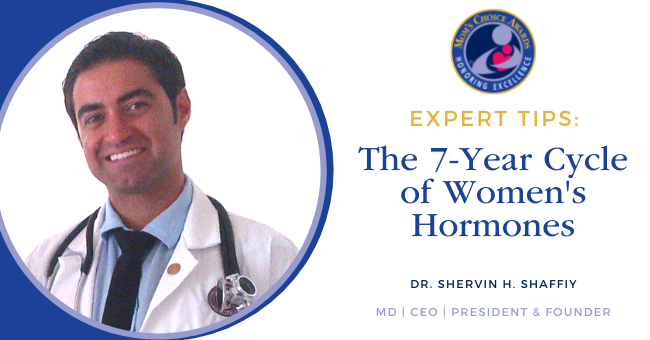 Dr. Shervin H. Shaffiy
Dr. Shervin H. Shaffiy
MD | MSc| CEO | President & Founder
Facebook | Instagram
 We often talk about women’s menstrual cycles and their fertility cycles, but we don’t talk about the cycle that governs it all: the hormone cycle.
We often talk about women’s menstrual cycles and their fertility cycles, but we don’t talk about the cycle that governs it all: the hormone cycle.
Over the course of a woman’s life, her hormones go through different phases—seven, to be exact. Plus, each stage lasts about seven years. Naturally, these changes shape women’s reproductive health, but they also have an impact on women’s health overall. For instance, hormone fluctuations related to your menstrual cycle can intensify the symptoms associated with anxiety or depression, irritable bowel syndrome, anemia, and asthma, among others. Hormone changes can also elevate your risk for certain medical conditions, such as diabetes, heart disease, and osteoporosis.
All women should understand what these different cycles are so they can accurately and effectively monitor their hormone health for any potential issues. Here’s a look at each stage:
Puberty
The transition from girlhood to womanhood typically begins sometime between ages 10 and 14. The main hormone kick-starting puberty is GnRH, or gonadotropin-releasing hormone. When released from the pituitary gland, GnRH triggers a domino effect of other hormones.
Luteinizing and follicle-stimulating hormones (LH and FSH, respectively) hit the bloodstream and travel to the ovaries. In a way, these hormones wake up the ovaries as this is where estrogen production begins.
All of this new hormone activity brings noticeable change. Breast development begins, the body starts to fill out its curves, and body hair starts growing. A couple of years after breast development commences, menstruation starts. During the early stages, irregular periods are not uncommon as the body adjusts its hormone levels.
Menstruation
From about age 21 through age 35, a woman enters her normal adult menstruation cycle. Each month, the body prepares itself for a potential pregnancy by releasing high amounts of estrogen and progesterone.
Estrogen supports the development of the ovarian follicle that will produce an egg during ovulation. Progesterone thickens the uterine wall so if the egg is fertilized by a sperm it can be safely implanted in the uterus. Without a fertilized egg, estrogen and progesterone decrease once they hit their lowest levels, and the cycle starts all over again.
Some women experience PMS (premenstrual syndrome) as a result of the increase in hormones prior to their period. These symptoms may include tiredness, cramps, bloating, breast soreness, and cravings for particular foods.
Hormone imbalances can lead to irregular cycles during this stage. Erratic menstrual patterns can also be influenced by stress, poor diet, and lack of exercise. Women suffering from irregular periods should consult with their physicians about potential medical issues.
Pregnancy
Normal hormone levels are important during this part of the hormone cycle. As noted, estrogen and progesterone are high in the lead-up to ovulation. With pregnancy, those hormone levels continue to increase to support both mother and baby. (This increase may also have a not-so-pleasant side effect: morning sickness.)
Estrogen is necessary for a strong and healthy uterus and placenta that supports a growing fetus. The hormone also prepares a mother-to-be for breastfeeding by readying the milk ducts in the breasts. Progesterone helps the uterus expand as the baby grows in size and also supports prenatal development.
Women who have fertility issues may not have enough natural progesterone production; additionally, medication given during certain fertility treatments may also lower progesterone levels. In cases like these, women may often be prescribed a progesterone supplement in the form of a suppository or injection. Women who experience difficulty conceiving may want to get their hormone levels checked to see if that’s the cause of their infertility issues.
Postpartum
The hormonal high that women ride dissipates rather quickly, just shortly after the baby is born. Two new hormones then come to the forefront: oxytocin and prolactin. Oxytocin is a feel-good hormone, while prolactin helps with breastfeeding.
Some women may experience mood swings as these various hormone levels fluctuate. Throw in the stress hormone cortisol, and the ups and downs can intensify to the point where postpartum depression occurs. A hormone imbalance may also cause weight gain, fibroids, or decreased sex drive. On the positive side, women who had steady hormone levels prior to pregnancy should expect to return to normal about six months after the baby’s birth.
Perimenopause
This can actually be split into two phases. Starting around age 35, estrogen and progesterone begin to gradually decrease. However, most women won’t notice as there isn’t much apparent evidence that change is occurring. But it’s the beginning of the transition to menopause when women stop having periods altogether.
The second, more noticeable stage typically starts around age 45. Periods may become more irregular as estrogen and progesterone production become erratic. Menstruation may not happen as frequently (it’s common to skip a few months between cycles), and blood flow may be lighter or heavier.
During this cycle, PMS symptoms and mood swings may intensify. Some women experience hot flashes or vaginal dryness. Lower estrogen, in particular, can increase the risk of bone loss and higher cholesterol levels, the latter of which can lead to an increased likelihood of heart disease.
The duration of perimenopause is different for each person—it can be as short as two years or as long as eight to 10 years. Once estrogen and progesterone have decreased to the point that a woman hasn’t menstruated in a year, she has officially reached menopause.
Postmenopause
Estrogen and progesterone stay low for women after age 55 or so. However, some of them may still experience hot flashes or vaginal dryness post-menopause because of too-low hormone levels.
Aiming for Healthy Hormone Levels
Healthy lifestyle habits—such as eating nutritious foods, exercising regularly, abstaining from cigarette smoking, getting enough sleep—support healthy hormone levels. It’s also wise for women to monitor their levels throughout the stages of their hormone cycle. Some women may need to do this if they’re trying to have a baby and want to ensure they’re ovulating normally. Other women may want the information as they decide whether to have hormone therapy replacement during perimenopause.
Regular testing is an easy way to track fluctuations and spot potential problems early on. At-home hormone tests can be conducted in the comfort of one’s home, and the most advanced tests can deliver results within a few days. Hormone health is a key factor in women’s health and well-being, so every woman should take advantage of all that testing has to offer.
 About Dr. Shervin H. Shaffiy
About Dr. Shervin H. Shaffiy
Medically Reviewed by Dr. Shervin H. Shaffiy, MD, MSc, Advisory Board Member of True Marker, CEO of S&S Wellness & Aesthetics, President & Founder of Eco-Medical Solutions, St. George’s University School of Medicine
True Marker is a Los Angeles-based, state-of-the-art reference laboratory designed to deliver a better at-home health experience. Launching June 2021, the organization provides easy, affordable, and convenient at-home testing that can quickly diagnose a range of health conditions. To learn more, please visit True Marker.
View all posts by Shervin H. Shaffiy here.







2 Comments on “The 7-Year Cycle of Women’s Hormones”
ahhh those things called hormones… yep, I have experienced many of the things listed above and now at 55 am in the final stretch. I have been prescribed hormones as I was experiencing some issues, and they seem to have helped. great article, enjoyed reading it!
I was hoping to read that hot flashes quit but I guess they don’t always. I am 53 and have been in menopause for 4 years. I still have hot flashes.